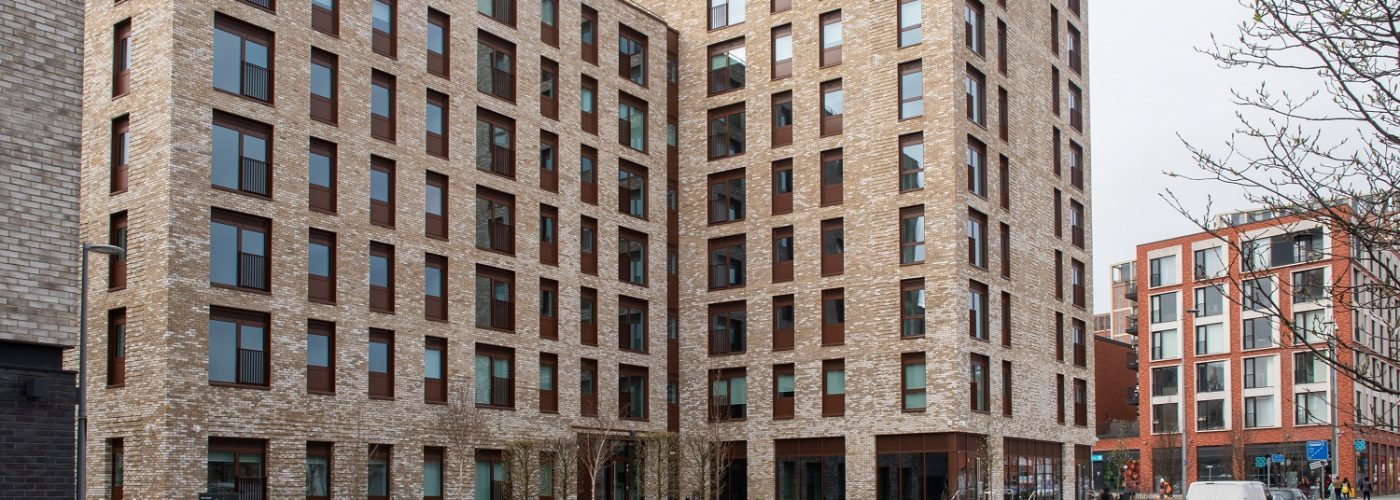Largest Passivhaus affordable housing scheme in the North West completes
Greenhaus – the largest Passivhaus Classic Certified development in the North West – has completed, bringing 96 highly-sustainable, affordable homes to Chapel Street in Salford.
The monthly cost of heating and hot water at Greenhaus is expected to be less than half that of a similar sized new-build home with a gas boiler.
Built to Passivhaus Classic certified standard, the leading low-energy design standard, the nine-storey development provides homes which offer high thermal comfort and improved air quality, enabling a healthier living environment as well as lower bills.
Bridging a gap in the housing sector for affordable, high specification living, Greenhaus has been delivered by ECF – a joint venture between three of the UK’s leading regeneration and investment organisations, Homes England, Legal & General, and Muse – alongside Salford housing association, Salix Homes, and supported by Salford City Council.
Greenhaus is part of ECF’s £1bn, 50-acre Salford Central transformation being delivered in partnership with Salford City Council and takes the overall percentage of affordable homes delivered by ECF to 25% across the Chapel Street area of the masterplan.
Following Greenhaus’ success, work is soon to start on a second Passivhaus development on nearby Peru Street, which will deliver a further 100 affordable and highly sustainable apartments.
Salford City Mayor Paul Dennett was at the official launch of Greenhaus (on Monday 18 March) where he hailed the development as “the benchmark” for new-build, affordable, and sustainable homes and commented: “We continue to be immensely proud of the innovation and drive to deliver forward thinking, sustainable developments in Salford – testament to the culture our city fosters and shares with our broader region. The regeneration of Salford is burgeoning and our future looking brighter and greener with each and every milestone we reach. We also work to ensure that local people can benefit for the growth and development that is taking place here – creating new jobs and opportunities for all.”
The first residents have begun moving into Greenhaus this week, including mature student Harriette Matthews. The 29-year-old, who is studying to be a counsellor, has been staying on her dad’s sofa in his one-bedroom flat for the past seven months, following a relationship breakdown. Harriette has autism and is a sufferer of scoliosis, which is a curvature of the spine, and her difficult living conditions have been affecting both her physical and mental health. Allocated one of the 13 apartments available for affordable rent[1] at Greenhaus, Harriette says moving into Greenhaus will transform her life: “I just can’t put into words how much of a difference having my own home will make to my life. When I got the call from my housing officer at Salix Homes to say I had a place at Greenhaus, I just couldn’t believe it – I feel so lucky.”
And the building’s eco-credentials are the icing on the cake for Harriette: “I know all about Passivhaus as I’d seen it on Grand Designs, and I always said to myself that when I get my own place, I want it to be Passivhaus, and now I’m living in one – it couldn’t be more perfect. I grew up around Manchester, but my dad is a born and bred Salfordian, so Salford has a special place in my heart.”

Salix Homes secured funding from NatWest, along with grants from Homes England and Greater Manchester Combined Authority (GMCA) to help fund the multi-million-pound scheme, which supports the GMCA’s ambitions for more truly affordable net zero homes.
Sue Sutton, Chief Executive at Salix Homes, said: “We are incredibly proud to welcome the first residents to Greenhaus, and see our vision for high quality, affordable and sustainable housing brought to life.
“With the rising cost of living, a shortage in the supply of affordable and social housing, and a need to address the challenges posed by the climate crisis, Greenhaus demonstrates what can be achieved through effective partnership working, and a shared desire to create cleaner, greener, and healthier homes that are fit for the future and won’t need retrofitting.
“To help use the development’s green credentials effectively, Salix Homes will also be embarking on a careful education and monitoring process, supporting residents to get the most of out of their new homes. We’ll be monitoring the air quality and energy usage, so we can track the long-term benefits and identify lessons learned for future developments.”
Commenting on the completion of this ground-breaking development, Simon Hourihan, Project Director at Muse, said: “It is a wonderful moment to see residents moving into Greenhaus; a development that shows what can be achieved through collaboration on a shared vision and a real desire to deliver something pioneering rather than simply maintaining the status quo.
“Our learnings from Greenhaus can also be shared for future developments which will help to shape other sustainable schemes for the benefit of people and the environment. We’ve loved the challenge of delivering the largest Passivhaus scheme of its kind in the North West and can’t wait to see the positive impact this scheme has on its residents.”
Danielle Gillespie, Director of Regeneration, Partnerships and Major Projects, Homes England, commented: “The completion of Greenhaus in Salford, delivered by the English Cities Fund, is a significant achievement. The creation of new affordable, sustainable, and high specification homes contributes to a wider ambition to create healthy living environments which serve the needs and desires of local communities.”
Wes Erlam, Managing Director of Urban Regeneration, Legal & General Capital, added: “Social and environmental benefits don’t have to be add-ons to investments: it is possible to pursue and create opportunities that generate long-term, secure income streams whilst also tackling some of the major social, environmental and economic issues facing society. Both the Greenhaus development and ECF’s wider partnership with Salford City Council underscore the many benefits that come from collaboration between investors, developers, and the public sector, and we’re proud to be delivering positive place-based impacts for Salford now and for the long-term.”
Designed by architects Buttress, the new homes incorporate a range of benefits for occupiers including triple glazing, air source heat pumps, and the latest in insulation technology which contribute to higher thermal comfort and improved air quality. These features, in turn, contribute to a healthier living environment by reducing the risk of damp, mould, and condensation.
Outside, residents will also benefit from electric vehicle charging points and a public square complete with landscaping to foster and encourage community spirit.
Heather Mason, Senior Architect, Buttress, added: “Inspired by our commitment to merging outstanding design with sustainability, Greenhaus stands as a testament to Buttress’ passion for innovation. From the project’s inception, we collaborated meticulously with the development team navigating through the design and construction stages and their sequencing to ensure the high standards of Passivhaus.
“The architectural vision was significantly shaped by the proximity to the Cathedral of St John the Evangelist, aiming to provide Greenhaus residents with a unique experience of the surrounding landscape and amenities.”
Greenhaus is a mixed tenure development of one- and two-bedroom homes, including two accessible apartments on the ground floor. It comprises 11 homes for social rent, 13 homes for affordable rent and 72 homes available as part of the Rent to Buy scheme. The homes were built by lead contractor Eric Wright Construction.

Building, Design & Construction Magazine | The Choice of Industry Professionals





